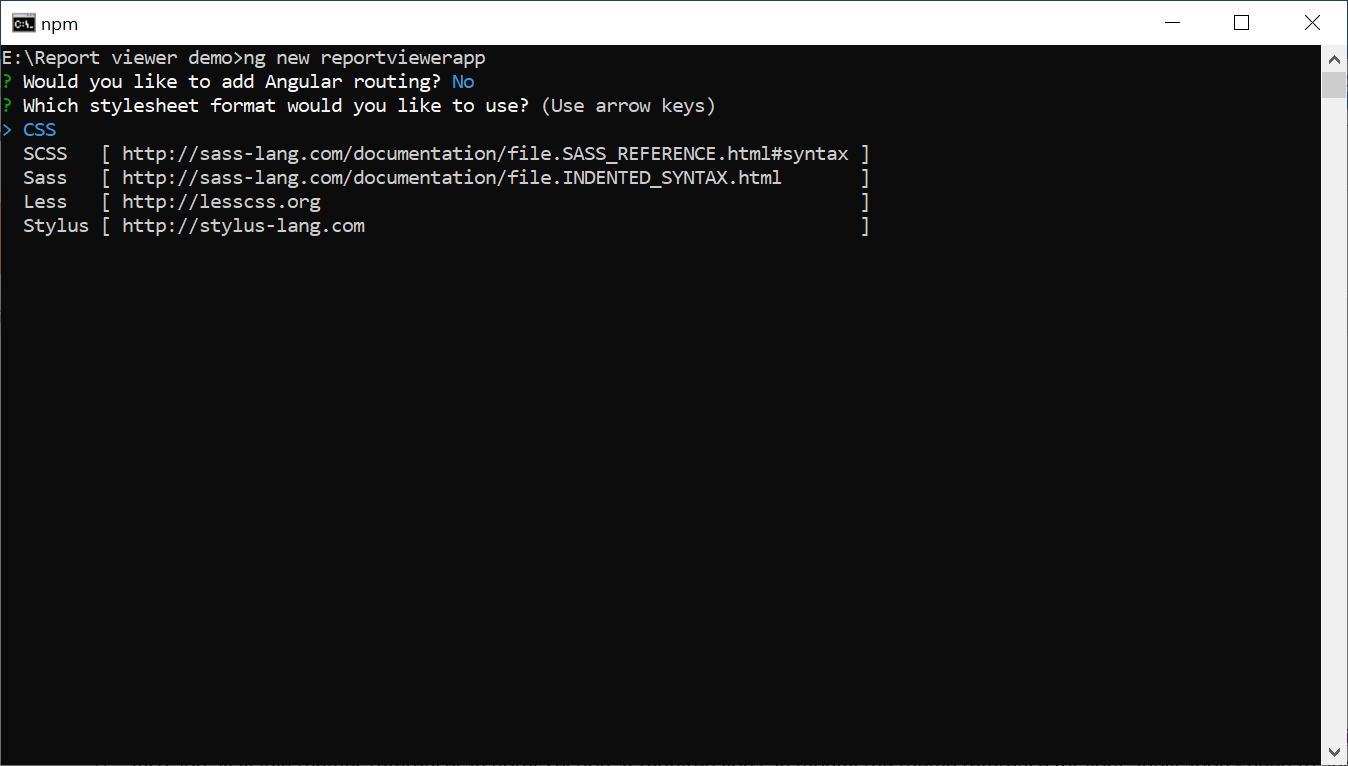Display SSRS RDL report in Bold Reports® Angular Report Viewer
This section explains you the steps required to create your first Angular reporting application in Angular CLI to display already created SSRS RDL report in Bold Reports® Angular Report Viewer without using a Report Server, refer to the following steps.
If you are using higher version of Bold Reports® Angular (>= v2.2.28), then refer Getting Started for latest version.
Prerequisites
Before you begin, make sure your development environment includes the following:
Install the Angular CLI
Angular provides the easiest way to set Angular CLI projects using the Angular CLI tool. To install the CLI application globally to your machine, run the following command in the Command Prompt.
npm install -g @angular/cliTo learn more about
angular-clicommands, click here.
Create a new application
To create a new Angular application, run the following command in the Command Prompt.
ng new project-name
E.g : ng new reportviewerappThe ng new command prompts you for information about features to include in the initial app project. Accept the defaults by pressing the Enter or Return key.

Configure Bold Report Viewer in Angular CLI
Bold reporting tools packages are distributed in NPM package as @boldreports/angular-reporting-components.
-
To configure the Report Viewer component, change the directory to your application’s root folder.
cd project-name E.g : cd reportviewerapp -
Run the following commands to install the dependencies.
npm install @boldreports/angular-reporting-components --save -
Install the typings dependencies
jqueryandboldreports/types.npm install --save-dev @types/jquery npm install --save-dev @boldreports/types -
Add the typings
jquery, andreports.allto thesrc/tsconfig.app.jsonfile.{ ... ... "compilerOptions": { ... ... "baseUrl": "", "types": [ "jquery", "reports.all" ] }, ... ... } -
Register the
@bold-reports/typesunder thetypeRootsnode in thetsconfig.jsonfile.
If you are using Angular project version 8.1.x or higher, You should set the
enableIvyoption tofalsein the project’stsconfig.jsonfile to resolve theBold Reportspackage compiling issue. -
Report Viewer requires
window.jQueryobject to render the component. Import jQuery in thesrc/polyfills.tsfile as shown in the following code snippet.import * as jquery from 'jquery'; window['jQuery'] = jquery; window['$'] = jquery;Refer to the already configured import codes in the webpack angular seed application.
Adding CSS reference
Add Report Viewer component style (bold.report-viewer.min.css) as given in the angular.json file within the pojectname -> styles section (Eg. reportviewerapp -> styles).
If you are using Angular 6 or lower version project, add the changes in the
angular-cli.jsonfile.
{
"$schema": "./node_modules/@angular/cli/lib/config/schema.json",
"project": {
"name": "reportviewerapp"
},
"reportviewerapp": [
{
"root": "src",
"outDir": "dist",
. . .
. . .
"styles": [
"styles.css",
"./node_modules/@boldreports/javascript-reporting-controls/Content/v2.0/tailwind-light/bold.report-viewer.min.css"
],
"scripts": [],
. . .
. . .
}In the previous code, the
tailwind-lighttheme is used. You can modify the theme based on your application, refer the following syntax:./node_modules/@boldreports/javascript-reporting-controls/Content/v2.0/[theme-name]/bold.report-viewer.min.css
Adding Report Viewer component
To add the Report Viewer component, refer to the following steps:
-
Open the
app.module.tsfile. -
You can replace the following code snippet in the
app.module.tsfile.import { BrowserModule } from '@angular/platform-browser'; import { NgModule } from '@angular/core'; import { BOLD_REPORTVIEWER_COMPONENTS } from '@boldreports/angular-reporting-components/src/reportviewer.component'; import { AppComponent } from './app.component'; import '@boldreports/javascript-reporting-controls/Scripts/v2.0/common/bold.reports.common.min'; import '@boldreports/javascript-reporting-controls/Scripts/v2.0/common/bold.reports.widgets.min'; import '@boldreports/javascript-reporting-controls/Scripts/v2.0/bold.report-viewer.min'; @NgModule({ declarations: [ AppComponent, BOLD_REPORTVIEWER_COMPONENTS ], imports: [ BrowserModule ], providers: [], bootstrap: [AppComponent] }) export class AppModule { } -
Open the
app.component.htmlfile and initialize the Report Viewer. -
You can replace the following code snippet in the
app.component.htmlfile.<bold-reportviewer id="reportViewer_Control" style="width: 100%;height: 950px"> </bold-reportviewer> -
Open the
app.component.tsand replace the following code example.import { Component } from '@angular/core'; @Component({ selector: 'app-root', templateUrl: './app.component.html', styleUrls: ['./app.component.css'] }) export class AppComponent { title = 'reportviewerapp'; public serviceUrl: string; public reportPath: string; constructor() { // Initialize the Report Viewer properties here. } }If you have faced the issue
'ej' is not definedafter the above configuration in Angular CLI latest version 7, refer to the following code snippet in your application where you have rendered Syncfusion® Components(model file) to resolve the issue.`/// <reference types="reports.all" />`
Create Web API service
The Report Viewer requires a Web API service to process the report files. You can skip this step and use the online Web API services to preview the already available reports or you should create any one of the following Web API services:
Adding already created report
If you have created a new service, you can add the reports from the Bold Reports® installation location. For more information, refer to samples and demos section.
-
Create a folder
Resourcesin your Web API application to store the RDL reports and add already created reports to it. -
Add already created reports to the newly created folder.
In this tutorial, the
sales-order-detail.rdlreport is used, and it can be downloaded in this link.
Refer to the create RDL report section for creating new reports.
Set report path and Web API service
To set report path and Web API service, open the app.component.ts file and add the codes as shown in the constructor.
import { Component } from '@angular/core';
@Component({
selector: 'app-root',
templateUrl: './app.component.html',
styleUrls: ['./app.component.css']
})
export class AppComponent {
title = 'jsreport-sample';
public serviceUrl: string;
public reportPath: string;
constructor() {
this.serviceUrl = 'https://demos.boldreports.com/services/api/ReportViewer';
this.reportPath = '~/Resources/docs/sales-order-detail.rdl';
}
}In the above code, the
sales-order-detail.rdlreport andreportServiceUrlused from online URL.
Open the app.component.html to set reportPath and reportServiceUrl properties of Report Viewer as in the following.
<bold-reportviewer id="reportViewer_Control" [reportServiceUrl] = "serviceUrl" [reportPath] = "reportPath" style="width: 100%;height: 950px">
</bold-reportviewer>Serve the application
To serve the application, follow these steps:
-
Navigate to the root of the application and run the application using the following command.
ng serve -
Navigate to the appropriate port
http://localhost:4200in the browser.
See Also
Set data source credential for shared data sources